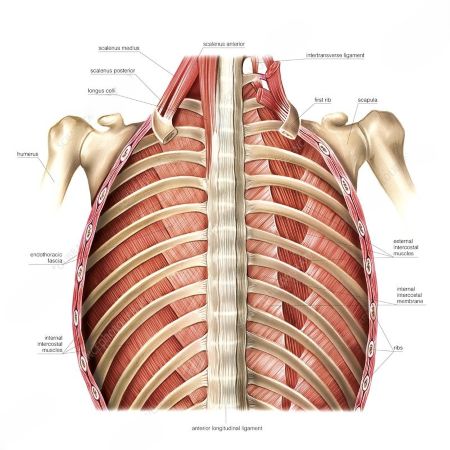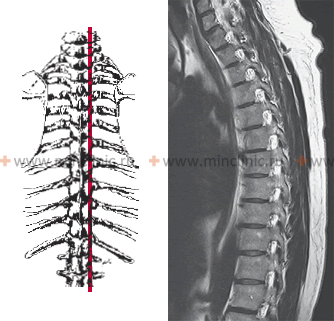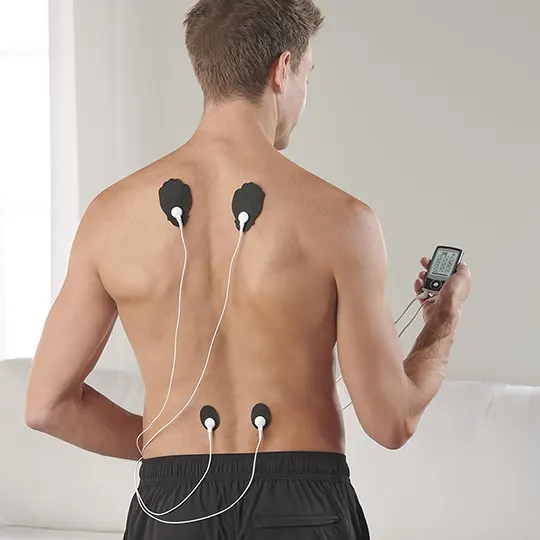Middle Back Pain: Causes, Diagnosis, and Treatment
Introduction to Middle Back Pain
Middle back pain, often synonymous with thoracic back pain, refers to discomfort experienced in the area between the base of the neck and the bottom of the rib cage. This region comprises the thoracic spine, which is relatively stable compared to the more mobile cervical (neck) and lumbar (lower back) regions. While less prevalent than neck or lower back pain, middle back pain can be equally debilitating and its causes range from simple muscle strains to more serious underlying conditions. Understanding the characteristics of this pain is crucial for accurate diagnosis and effective management.
Anatomy of the Middle Back
The middle back is structurally complex, providing support and protection for vital organs in the chest cavity. Key anatomical components include:
- Thoracic Vertebrae (T1-T12): These 12 vertebrae form the central part of the spine. Unlike other spinal segments, each thoracic vertebra articulates with a pair of ribs. More on Anatomy of the spine.
- Ribs: 12 pairs of ribs attach to the thoracic vertebrae, forming the rib cage, which protects the heart and lungs.
- Intervertebral Discs: Located between each vertebra, these cartilaginous discs act as shock absorbers. Information on Herniated and bulging intervertebral disc.
- Muscles: A dense network of muscles, including the erector spinae, rhomboids, trapezius, and intercostal muscles, provides movement and stability.
- Ligaments and Tendons: Strong fibrous tissues that connect bones and muscles, contributing to spinal stability.
- Spinal Cord and Nerves: The spinal cord runs through the vertebral canal, with thoracic nerves branching out to innervate the chest, abdomen, and parts of the arms. See Spinal cord diseases.
Common Causes of Middle Back Pain
Musculoskeletal Issues
- Muscle Strain or Spasm: Often caused by poor posture, prolonged sitting, heavy lifting, repetitive movements, or sports injuries. This is one of the most common causes of low back pain (spinal pain) and can affect the middle back.
- Poor Posture: Chronic slouching, rounding of the shoulders, or prolonged forward head posture can stress the muscles and ligaments of the thoracic spine, leading to pain and potentially poor posture.
- Myofascial Pain Syndrome: Characterized by trigger points in muscles that cause localized or referred pain.
Spinal Conditions
- Intervertebral Disc Problems: While less frequent than in the lumbar or cervical spine, herniated or bulging discs can occur in the thoracic region, leading to pain and nerve compression.
- Osteocondritis of the spine: Degenerative changes of the spinal discs and adjacent vertebral bodies.
- Spinal spondylosis: Degeneration of the spine, often involving bone spurs (osteophytes).
- Spondyloarthrosis (facet joint osteoarthritis): Arthritis affecting the small joints (facet joints) between the vertebrae.
- Compression Fracture of the Spine: Can result from trauma, falls, or weakened bones due to osteoporosis of the spine.
- Spinal Deformities: Conditions like Scoliosis (sideways curvature) or kyphosis (excessive forward curvature) can cause chronic pain due to uneven stress on the spine. Related condition is Scheuermann-Mau disease (juvenile osteochondrosis).
- Spinal Stenosis: Narrowing of the spinal canal, which can compress the spinal cord or nerve roots.
- Ankylosing Spondylitis (Bechterew's disease): A chronic inflammatory disease primarily affecting the spine, leading to stiffness and pain.
Rib-Related Issues
- Costochondritis: Inflammation of the cartilage that connects a rib to the breastbone (sternum). Pain can be felt in the front of the chest and radiate to the back.
- Rib Fractures: Can cause sharp, localized pain, especially with deep breaths or movement.
- Rib Dysfunction: A rib can become displaced or "out of place" at its joint with the vertebra, causing acute pain, often described as a sharp catch. This can lead to intercostal neuralgia.
Referred Pain from Organs
Pain in the middle back can sometimes originate from internal organs, a phenomenon known as referred pain. Conditions include:
- Cardiac Issues: Heart attack or angina can refer pain to the back, arm, or jaw.
- Pulmonary Conditions: Lung infections (pneumonia), pleurisy, or even lung cancer can cause back pain.
- Gastrointestinal Problems: Peptic ulcers, pancreatitis, gallbladder disease, or esophageal issues can refer pain to the thoracic spine.
- Kidney Issues: Kidney stones or infections can cause flank pain that radiates to the middle back.
Other Causes
- Nerve Compression/Irritation: From disc issues, bone spurs, or other conditions. Can lead to pain in the thoracic spine, intercostal neuralgia.
- Tumors: Benign or malignant growths in the spine, spinal cord (Non-compression oncological myelopathies), or surrounding tissues. Vertebral hemangiomas are a specific type.
- Infections: Such as spondylitis (osteomyelitic, tuberculous) or Spinal bacterial (purulent) epiduritis.
- Shingles: A viral infection that can cause painful rash and nerve pain along a dermatome in the middle back.
- Whiplash neck injury, cervico-cranial syndrome: Though primarily neck pain, severe cases can affect the upper thoracic region.
In intercostal neuralgia resulting from herpes zoster (shingles), a characteristic rash of painful blisters (vesicles) appears on the skin overlying the affected intercostal nerve(s).
Associated Symptoms
Middle back pain can be accompanied by various symptoms depending on the underlying cause:
- Localized sharp, dull, aching, or burning pain.
- Stiffness, especially in the morning or after prolonged inactivity.
- Muscle spasms or tenderness to touch.
- Pain that worsens with specific movements, coughing, or deep breaths.
- Numbness, tingling, or weakness in the arms, chest, or abdomen (suggestive of nerve involvement).
- Pain radiating around the rib cage (intercostal neuralgia).
- Difficulty breathing, chest pain, or gastrointestinal symptoms (if referred pain).
Diagnosis
A comprehensive diagnosis involves a detailed medical history, physical examination, and potentially imaging studies. The physician will assess posture, range of motion, neurological function, and palpate for tenderness and muscle spasms.
- X-rays: Can identify bone abnormalities, fractures (compression fractures), and spinal curvatures (scoliosis, kyphosis).
- MRI (Magnetic Resonance Imaging): Provides detailed images of soft tissues, including intervertebral discs (herniated discs), ligaments, and the spinal cord (spinal cord diseases), useful for detecting nerve compression, tumors, or infections.
- CT (Computed Tomography) Scan: Offers more detailed bone imaging, particularly useful for complex fractures.
- Bone Scan: Can detect stress fractures, infections, or tumors.
- Electromyography (EMG) and Nerve Conduction Studies (NCS): May be used to assess nerve damage or compression.
- Blood Tests: To check for inflammation (e.g., in Ankylosing Spondylitis) or infection.
Differential Diagnosis Table
Distinguishing between the various causes of middle back pain is crucial for appropriate treatment. This table outlines common conditions and their differentiating features:
| Condition | Key Symptoms | Contributing Factors | Diagnostic Clues |
|---|---|---|---|
| Muscle Strain/Spasm | Localized ache, tenderness, stiffness; often acute onset after activity. | Poor posture, overuse, heavy lifting, stress. | Pain reproduced with palpation; relieved by rest/heat; absence of neurological signs. |
| Herniated Disc | Sharp, radiating pain around chest/abdomen; numbness, tingling, weakness (rare). | Trauma, degeneration, heavy lifting. | Neurological deficits (if present); confirmed by MRI. |
| Compression Fracture | Sudden, severe pain, worse with standing/walking; often in osteoporotic individuals. | Osteoporosis, trauma, cancer. | X-ray, CT, or MRI showing vertebral body collapse. |
| Scoliosis / Kyphosis | Chronic ache, fatigue; visible spinal curvature, uneven shoulders/hips. | Congenital, idiopathic, degenerative. | Physical exam revealing curvature; confirmed by X-ray. |
| Rib Dysfunction/Intercostal Neuralgia | Sharp, stabbing pain, often unilateral, worse with deep breath or trunk rotation. | Trauma, sudden movement, viral infection (e.g., shingles). | Localized tenderness at rib-vertebra joint; dermatomal pain pattern for neuralgia. |
| Spondylitis / Epiduritis | Severe, progressive pain; fever, chills, malaise; neurological deficits. | Bacterial infection (e.g., TB, staph). | Elevated inflammatory markers; positive cultures; MRI showing infection. |
| Referred Pain (e.g., Cardiac, GI) | Back pain accompanied by chest pain, shortness of breath, heartburn, abdominal pain. | Heart disease, lung conditions, gallstones, pancreatitis. | Absence of spinal tenderness; positive findings on cardiac, pulmonary, or abdominal workup. |
Treatment Approaches
Treatment for middle back pain is highly dependent on the diagnosis and severity. Options range from conservative management to surgical intervention.
- Conservative Management:
- Rest and Activity Modification: Avoiding activities that aggravate pain while maintaining some gentle movement.
- Physical Therapy: Focuses on core strength, back muscle endurance, flexibility, posture correction, and manual therapy techniques. This is particularly important for scoliosis and general spinal pain.
- Medications: Over-the-counter pain relievers (NSAIDs), muscle relaxants, or prescription pain medications.
- Heat and Cold Therapy: Application of heat to relax muscles and cold to reduce inflammation.
- Massage Therapy: Can alleviate muscle tension and improve blood flow.
- Acupuncture: May provide pain relief for some individuals.
- Chiropractic Care: Spinal adjustments can help with misaligned vertebrae or rib dysfunction.
- Injections:
- Epidural Steroid Injections: Can reduce inflammation around compressed nerves.
- Facet Joint Injections: For pain originating from the facet joints (spondyloarthrosis).
- Trigger Point Injections: Directly into painful muscle knots.
- Surgical Intervention:
- Seldom required for middle back pain. It is considered for severe cases involving spinal cord compression (Compression of the spinal cord), significant spinal instability, or unrelenting pain that does not respond to conservative treatments, such as large herniated discs or severe spinal stenosis.
- Procedures might include discectomy, laminectomy, or spinal fusion, depending on the specific pathology.
Exercise or back extensor muscles.
Prevention
Preventing middle back pain involves a combination of healthy habits and ergonomic considerations:
- Maintain good posture during sitting, standing, and lifting activities.
- Incorporate regular exercise focusing on core strength, back muscle endurance, and flexibility.
- Use ergonomic furniture and adjust your workstation to support neutral spinal alignment.
- Practice proper lifting techniques, lifting with your legs, not your back.
- Take frequent breaks to stretch and move if you have a sedentary job.
- Manage stress, as it can contribute to muscle tension.
- Maintain a healthy weight to reduce stress on your spine.
References
- Moore, K. L., Dalley, A. F., & Agur, A. M. R. (2018). *Clinically Oriented Anatomy* (8th ed.). Lippincott Williams & Wilkins.
- Bogduk, N. (2005). *Clinical Anatomy of the Lumbar Spine and Sacrum* (4th ed.). Elsevier Churchill Livingstone. (Though primarily lumbar, principles of spinal pain apply).
- Magee, D. J. (2014). *Orthopedic Physical Assessment* (6th ed.). Saunders.
- Travell, J. G., & Simons, D. G. (1999). *Myofascial Pain and Dysfunction: The Trigger Point Manual (Vol. 1: Upper Half of Body).* Lippincott Williams & Wilkins.
- Panjabi, M. M. (1992). The stabilizing system of the spine. *Journal of Spinal Disorders*, 5(4), 383-389.
- Netter, F. H. (2014). *Atlas of Human Anatomy* (6th ed.). Saunders.
See also
- Anatomy of the spine
- Ankylosing spondylitis (Bechterew's disease)
- Back pain by the region of the spine:
- Back pain during pregnancy
- Coccygodynia (tailbone pain)
- Compression fracture of the spine
- Dislocation and subluxation of the vertebrae
- Herniated and bulging intervertebral disc
- Lumbago (low back pain) and sciatica
- Osteoarthritis of the sacroiliac joint
- Osteocondritis of the spine
- Osteoporosis of the spine
- Guidelines for Caregiving for Individuals with Paraplegia and Tetraplegia
- Sacrodinia (pain in the sacrum)
- Sacroiliitis (inflammation of the sacroiliac joint)
- Scheuermann-Mau disease (juvenile osteochondrosis)
- Scoliosis, poor posture
- Spinal bacterial (purulent) epiduritis
- Spinal cord diseases:
- Spinal spondylosis
- Spinal stenosis
- Spine abnormalities
- Spondylitis (osteomyelitic, tuberculous)
- Spondyloarthrosis (facet joint osteoarthritis)
- Spondylolisthesis (displacement and instability of the spine)
- Symptom of pain in the neck, head, and arm
- Pain in the thoracic spine, intercostal neuralgia
- Vertebral hemangiomas (spinal angiomas)
- Whiplash neck injury, cervico-cranial syndrome





